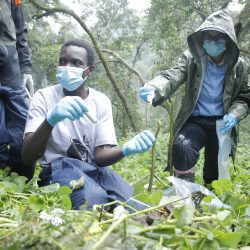Camera Traps Deployed to Monitor Biodiversity in Volcanoes National Park
Blog | 23/01/20
About 29 camera traps have been deployed by IGCP in partnership with the Rwanda Development Board in Volcanoes national park. This current deployment of camera traps at various heights is expected to help in documenting vertebrates inhabiting the canopies and species that rarely use the ground e.g birds. The initiative is a pilot study on the use of arboreal cameras for biodiversity monitoring in the mountain gorilla habitat. Thanks to WWF Sweden for funding this initiative. According to Dr. Jennifer Moore, the project’s external collaborator, it will be interesting to observe the cameras capturing one or multiple species which were previously unknown or undetected using the classic ground cameras.

Commenting on this initiative, Eustrate Uzabaho, IGCP’s Field Officer says they are hopeful that they will find useful information in terms of species occurrence at different tree heights and plant species preferences. “We are also optimistic that the survey methods which produced good results for Nyungwe National Park will be also rewarding in the volcanoes”. In this pilot study 14 sites previously used for Tropical Ecology Assessment and Monitoring (TEAM) work will be surveyed using the same standardized protocol throughout the park. IGCP is partnering with the Institute of Tropical Forest Conservation for a similar pilot initiative in Bwindi Impenetrable National Park,Uganda.



